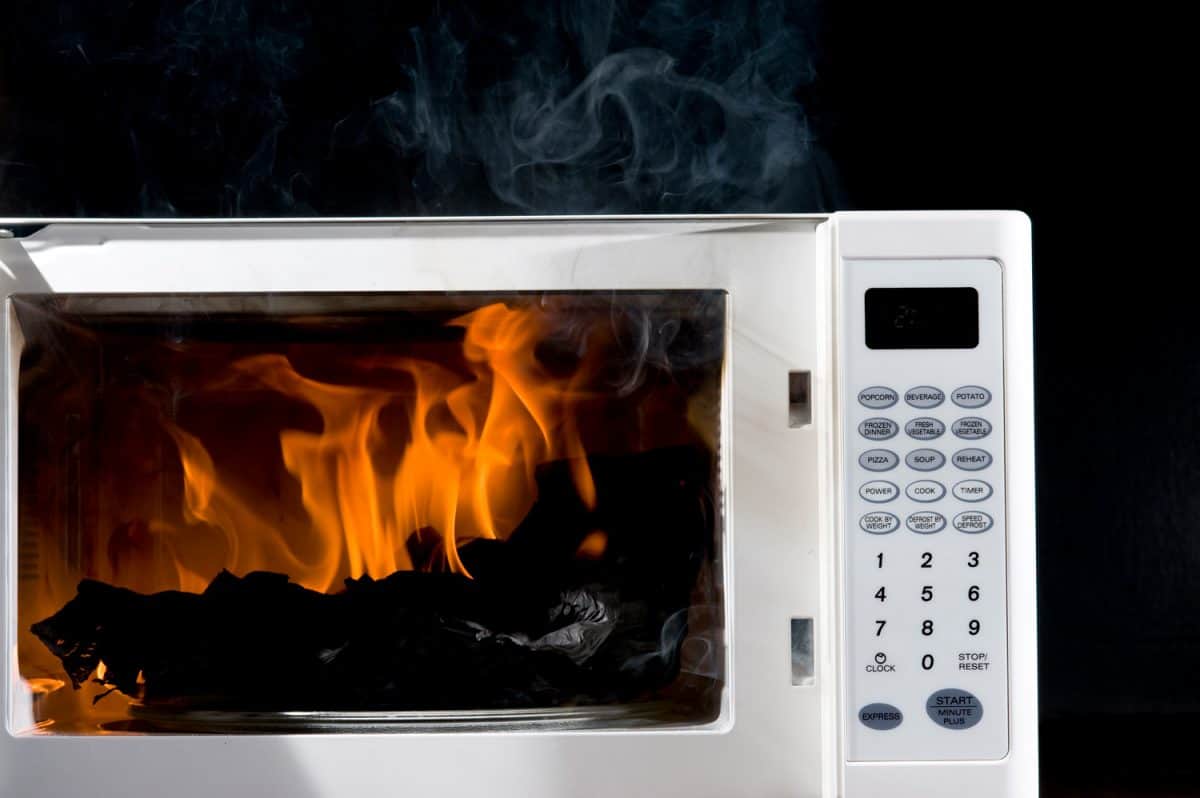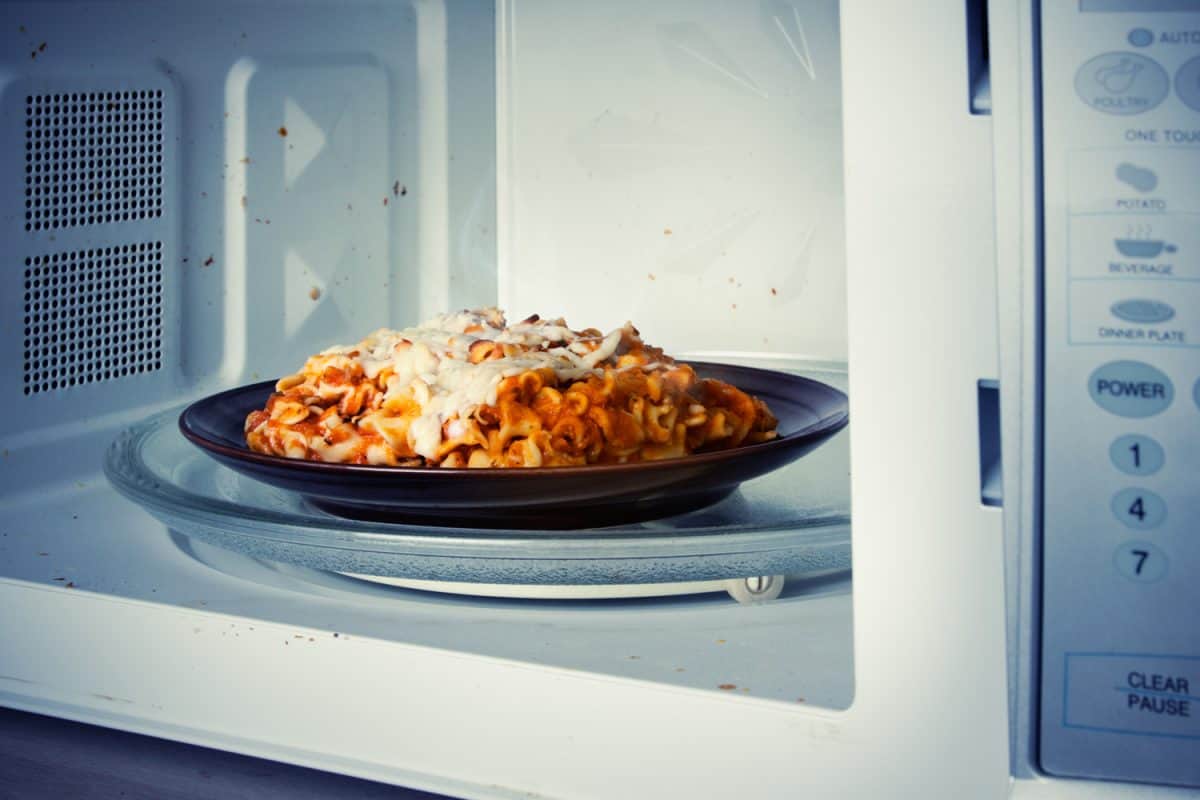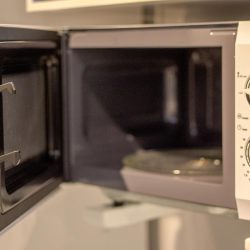Microwaves are the ultimate kitchen convenience appliance. They can heat your food without putting in effort on your part. However, you might have noticed that it is sparking. It might be strange because there's no metal inside. So, what could be causing the microwave to spark? We researched this topic to get you all the information you need about this.
If you're noticing a spark in the microwave when using it, you should stop it immediately. Next, let the microwave settle before you open it. Once ready, inspect the inside for any metal scraps that might have snuck in. If you find no definite signs of metal, there can be other causes for the sparks. The causes include:
- Reheating foods high in nitrates
- Diode burn
- Damaged waveguide cover
- Worn out rack support
These are some of the causes for a spark. Of course, there's still more you might want to know. Can sparks cause an explosion in a microwave? Is it a fire hazard if a microwave sparks? If you'd like to learn this and more, keep reading ahead.

Microwave Sparking
There are many reasons why a microwave could spark. Although you might be sure there is no metal inside, it's still viable to check for any scraps that may have snuck in. Did you use aluminum foil to wrap your food? Even a tiny bit of foil can cause a spark inside the microwave.
Did you recently clean the inside with steel wool? Make sure there are no traces of metal inside. If this isn't the case, let's move on to the other causes.
Reheating Foods High in Nitrates

Now that you're sure there is no metal in the microwave, you might be surprised to know some foods and cookware cause the microwave to spark. For example, grapes are one type of food that you should avoid putting inside a microwave.
Concentration of Minerals
In general, vegetables and fruit have the potential to produce an arc. Plants store micronutrients in the roots. The micronutrients include minerals like iron. So, there's a metal present in your food that could cause the microwave to spark.
However, iron isn't the only requirement for the spark-inducing event. As the article goes on, it states that having pointy edges in the iron deposits helps produce this arc.
In their words, think of it as a lightning rod. Since the electric field does the cooking, any foods with metal will locally enhance the electric field. In simple terms, it creates a stronger electric field than the air around it.
Putting it all together, if we cut kale and leave some areas sharp enough, it should spark if there's a high concentration of minerals. In some cases, it might even reflect energy back into the microwave, forcing it to shut down.
Sparking in Action
In writing, it sounds like a weird phenomenon. The results can vary since not all vegetables are the same. One food can contain minerals inside but, it may not even spark! Other foods like grapes can have a different reaction! So, if you'd like to see an example, here's a YouTube video demonstrating it with a grape!
It might pique your interest but remember not to try it out at home!
In general, you should avoid reheating foods high in nitrates. These foods include:
- Spinach/leafy greens
- Celery
- Carrots
- Turnips
- Green beans
Diode Burn
Another potential cause could be a diode burn. A diode works alongside a capacitor and magneton to produce heat. The diode will start to produce sparks while the microwave is running when it is shorted or opened.
As some suggest, you'll need to test the diode for continuity in both directions. To do so, you will need to:
- Unplug the power cord and discharge the high voltage capacitor.
- Look for the high voltage diode and remove it from the microwave. The diode is a cylinder with one line protruding from the bottom of each side.
- Using a multimeter, set it to Rx1 and touch the probes to the terminals.
- Now you'll want to check for continuity in the opposite direction. So, reverse the probes.
- Continuity on one side is a good indicator. However, if it shows continuity on both sides of the opposite case, you'll need a replacement diode.
If you don't believe you can do this yourself, you can call a repair person to fix it. Otherwise, you can replace the microwave with a new one.
Click here to see this diode on Amazon.
Damaged Waveguide Cover
Waveguides are in charge of transmitting microwave radiation. The small screen on the inside of the microwave is the waveguide. It's a brittle component that can be easily damaged. Putting in a dish in a hurry can be enough to damage it.
Inspect the area and check for cracks or any signs of damage. If it shows signs of wear, you should consider replacing the waveguide with a new one. However, depending on how expensive your microwave is, it might be simple to buy a new microwave. More expensive microwaves should have their waveguides replaced.
Click here to see this waveguide on Amazon.
Worn Out Rack Support
Some microwaves may contain racks inside. They are usually coated with paint to avoid exposing the metal to the waves. To remedy this problem, you'll have to replace it with a new one. However, you might also want to inspect the hooks that support the rack.
Over time, the hooks can also have the paint wear off. In this case, the fix is not as simple. It requires a more involved process.
Is It Safe To Use a Microwave After It Sparks?
Let's say you saw the microwave spark but, you still want to reheat your food! Is it safe to use after the event? As some users suggest, it should be fine as long as the magnetron survives. However, the real question is, should you?
In that regard, no. If you continue to use it, you might deliver lower voltage shocks to the unit. In the worst case, your microwave will no longer work.
Can a Sparking Microwave Explode?
Certain foods or materials can explode inside your microwave. However, the microwave itself is not in any danger of exploding. As some users suggest, microwaves have metal walls that reflect energy to heat your food. If you put another item that reflects energy inside, it will have nowhere to send the microwaves towards.
So, it goes for the next best thing. It will look for an object that can absorb the energy. The outcome will vary on what's inside the microwave. It might melt a component inside. All of this is contained within the microwave. Therefore, there's should be no worries about a microwave explosion.
Can a Microwave Cause a Fire?

Consequently, if it can't explode, can it cause a fire? In any case, yes, it can! There are lots of materials that can produce enough heat to start a fire. Things like metallic items and paper products can cause fires. Even turning the microwave with nothing in it can cause one!
The reason is that it will absorb its own energy. So, some components within will receive it and melt. There are also external causes for microwave fires. Microwaves need adequate space for their vents. If it's blocked, it can trap heat and catch on fire.
Are you fixing a component inside without professional help? If you aren't careful enough, you might end up damaging other parts inside. Consequently, the next time you turn it on, it can malfunction and start a fire.
Can a Dirty Microwave Cause Sparks?

Sometimes we're in a rush. So, we can forget to clean the inside of a microwave. In this situation, the microwave might have food remnants from previous reheating. Some of it may end up on the waveguide. If there's enough buildup, yes, it may spark.
As you might have learned, some foods can also contain minerals that can produce sparks as a reaction with microwaves. Again, if you leave too much buildup, there is a possibility that it can spark. So, if you want to avoid these situations, you should regularly clean the unit.
What Are the Signs That a Microwave Is Going Bad?
Now that you know the causes of your sparks, you might also want to know when it's time to replace the microwave. After all, wouldn't it be better not to create a fire hazard? Luckily, you can catch the signs early. Here are some of the symptoms of a malfunctioning microwave:
- It's starting to produce smoke and a burning smell. This symptom is an indication that components are beginning to fail.
- Reheating food is taking longer. Again, this is an indicator of degrading parts inside the microwave.
- The door is no longer sealing correctly. It is in charge of keeping the radiation contained. Once it no longer closes, it's time for a replacement unit.
- It's more than ten years old. Most microwaves are rated to last about nine to ten years. After this timeframe, you might want to consider replacing it with a newer model.
Final Takeaway
Although microwaves can be the ultimate convenience tools, they can also complicate our lives. Not all foods are the same. Likewise, materials also react differently to the waves put on them. So, in some cases, we'll witness the odd spark or two. We hope you found the information above insightful.
Before you go, do you have other microwave concerns? Are you wondering how often you should replace one? You can find out more by checking out our post here.
Are you planning on mounting the microwave over a range? You can find out how far it should be from the stove by checking out our post here. Until next time!





![Bread popping up of toaster on mint green background, Should A Toaster Spark? [What You Need to Know]](https://kitchenseer.com/wp-content/uploads/2021/08/Bread-popping-up-of-toaster-on-mint-green-background-250x250.jpg)


